 Kilmartin
Kilmartin
Scotland is rich, wild, romantic, and also very old. One of the finest examples of prehistoric Scotland is Kilmartin Glen. This glen boasts some 800 historic monuments, cairns, standing stones, stone circles and rock carvings, dating back over 5,000 years ago. For anyone who's even remotely interested in very old stuff, this place is a feast to one's eyes.
You can start in the Kilmartin Museum and marvel at the many finds that have been discovered in the glen. Outside the museum, there is Kilmartin Church (Kil means church) which houses some magnificently carved medieval grave slabs.
But it is outside where you can really get a sense of a civilisation that has long since disappeared. A seven-kilometre walk will take you along burial cairns, standing stones and rock carvings. It is a truly amazing experience, especially since you can climb on top of, and occasionally even venture inside such a cairn.
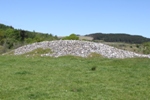 The first cairn you come across is Glebe cairn. It is part of the Linear Cemetery: a line of burial cairns dotting Kilmartin Glen. They were "re-discovered" in the nineteenth century when the glen was cleared of a thick layer of peat.
The first cairn you come across is Glebe cairn. It is part of the Linear Cemetery: a line of burial cairns dotting Kilmartin Glen. They were "re-discovered" in the nineteenth century when the glen was cleared of a thick layer of peat.
Unfortunately, 19th-century society
enthusiastically found new uses for the historic treasures, so Glebe cairn was swiftly reduced from at least four metres high and 33 metres in diameter back in 1864 to a significantly less impressive size today.
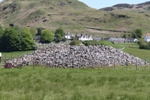 Some cairns were quarried away completely, so only a faint aerial impression remains. Others were completely reconstructed, such as Nether Largie North cairn. The cairn was rebuilt over a modern chamber and the great thing is you can check it out for yourself. Just walk on top of the cairn, slide back the trapdoor and descend the staircase to admire a large carved slab.
Some cairns were quarried away completely, so only a faint aerial impression remains. Others were completely reconstructed, such as Nether Largie North cairn. The cairn was rebuilt over a modern chamber and the great thing is you can check it out for yourself. Just walk on top of the cairn, slide back the trapdoor and descend the staircase to admire a large carved slab.
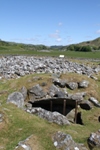 A bit further lies Nether Largie Mid cairn. It used to be at least three times as high as now. You can peep inside, but nothing more. Still, when you are standing there, you have a great view of the Glen and just how "linear" the line of cairns is. Even on this picture you can clearly see Glebe cairn in the back and Nether Largie North cairn in-between.
A bit further lies Nether Largie Mid cairn. It used to be at least three times as high as now. You can peep inside, but nothing more. Still, when you are standing there, you have a great view of the Glen and just how "linear" the line of cairns is. Even on this picture you can clearly see Glebe cairn in the back and Nether Largie North cairn in-between.
Most cairns are thought to be created around 1,500 BC. But there is one exception.
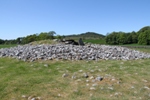
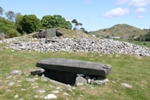 Nether Largie South cairn was built around 3,000 BC, so it is by far the oldest of the group. It contains a stone chamber, which you can visit. It is several metres long inside. I found it truly impressive.
Nether Largie South cairn was built around 3,000 BC, so it is by far the oldest of the group. It contains a stone chamber, which you can visit. It is several metres long inside. I found it truly impressive.
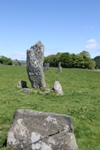 Before you get to the next cairn the walk takes you along several standing stones, one even more gigantic than the other. They are not far from Nether Largie South cairn, with a signpost reading Lady Glassary Wood. I guess it should not suprise anyone that they are a classic setting for photo shoots.
Before you get to the next cairn the walk takes you along several standing stones, one even more gigantic than the other. They are not far from Nether Largie South cairn, with a signpost reading Lady Glassary Wood. I guess it should not suprise anyone that they are a classic setting for photo shoots.
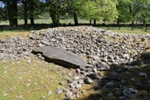 One last cairn lies ahead, and that is Ri Cruin cairn. It was originally about twenty metres in diameter, but it was robbed virtually completely. What you see today is a reconstruction. On the one hand, it makes me happy that at least something remains, but I find it difficult to understand how people in the mid-nineteenth century could show so little respect for their own history. But maybe that's just me.
One last cairn lies ahead, and that is Ri Cruin cairn. It was originally about twenty metres in diameter, but it was robbed virtually completely. What you see today is a reconstruction. On the one hand, it makes me happy that at least something remains, but I find it difficult to understand how people in the mid-nineteenth century could show so little respect for their own history. But maybe that's just me.
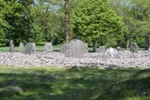
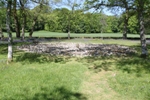 Last but not least, there is a final treat towards the end of the walk: Temple Wood. It is really the site of two circles, but as the first one was made in wood (on the right), obviously nothing much remains of that. The stone circle did leave traces you can admire today. This site was used well before 3,000 BC, so it predates any of the cairns.
Last but not least, there is a final treat towards the end of the walk: Temple Wood. It is really the site of two circles, but as the first one was made in wood (on the right), obviously nothing much remains of that. The stone circle did leave traces you can admire today. This site was used well before 3,000 BC, so it predates any of the cairns.
In May and early June the grass around the circles is one blue carpet of bluebells. It leaves a very pretty picture.
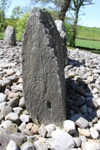 Kilmartin Glen boasts rock carvings on boulders, cists and slabs. Just open your eyes and they are everywhere.
Kilmartin Glen boasts rock carvings on boulders, cists and slabs. Just open your eyes and they are everywhere.
The centre monolith of Temple Wood is a fine example of prehistoric artwork.
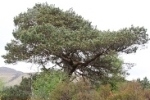 Home
Home
